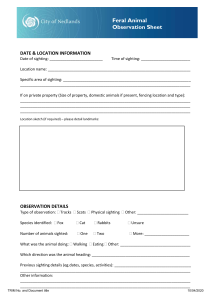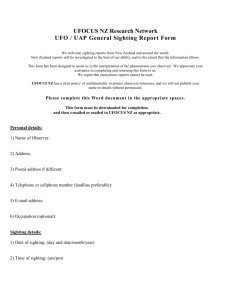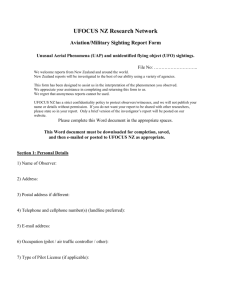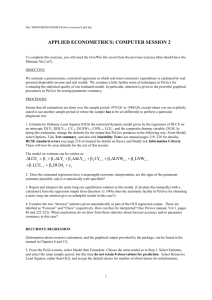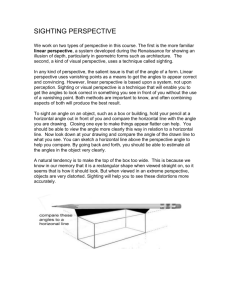Changes in dates of emergence from
advertisement
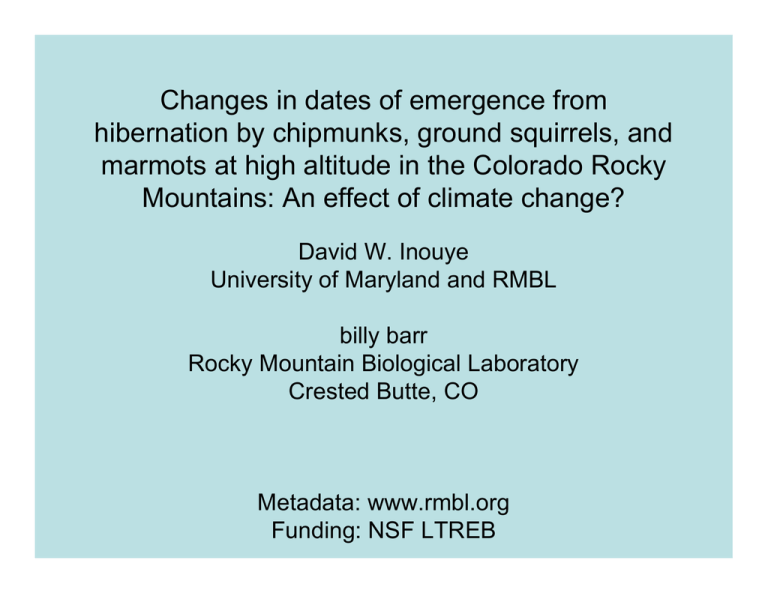
Changes in dates of emergence from hibernation by chipmunks, ground squirrels, and marmots at high altitude in the Colorado Rocky Mountains: An effect of climate change? David W. Inouye University of Maryland and RMBL billy barr Rocky Mountain Biological Laboratory Crested Butte, CO Metadata: www.rmbl.org Funding: NSF LTREB The Rocky Mountain Biological Laboratory 1800 Winter Snowfall in Gothic 1600 Snowfall (cm) 1400 1200 1000 800 600 400 200 0 1975 1980 1985 1990 1995 2000 2005 Chipmunk (Tamius minimus) Golden-mantled ground squirrels (Spermophilus lateralis) Yellow-bellied marmots (Marmota flaviventris) Day of year of first chipmunk sighting 130 120 110 100 90 1975 1980 1985 1990 1995 2000 2005 Day of year of first chipmunk sighting 130 120 110 100 90 1975 1980 1985 1990 1995 2000 2005 The North Pacific Oscillation (also known as PDO) Typical wintertime Sea Surface Temperature (colors), Sea Level Pressure (contours) and surface windstress (arrows) anomaly patterns during warm and cool phases warm phase cool phase http://tao.atmos.washington.edu/pdo/ Winter snowfall in Gothic (calculated from streamflow) 1800 2 r = .059 p = .0485 1600 19571995 1980 1952 1400 1978 1948 1200 1000 1973 1967 1964 1971 800 1965 1958 1949 1968 1938 1996 1951 1970 1943 1998 1985 1942 1982 1937 1989 1991 1947 1944 1969 1946 1945 1972 1974 1976 1990 1994 1960 1959 1939 1988 1966 2004 2000 1954 1953 1962 1975 1961 1979 2001 1963 2002 600 1977 400 -10 -5 0 5 Annual means for North Pacific Oscillation index Total snowfall in Gothic (cm) 1800 2 1600 r = .159 p = .060 1400 1200 1000 800 600 400 1975 1980 1985 1990 1995 2000 2005 Total snowfall in Gothic (cm) 1800 2 1600 r = .159 p = .060 1400 ? 1200 ? 1000 ? 800 ? 600 400 1975 1980 1985 1990 1995 2000 2005 2010 2015 2020 2025 Day of year of first chipmunk sighting 130 120 110 100 90 1975 1980 1985 1990 1995 2000 2005 Calendar day of first chipmunk sighting 170 19 June 160 150 140 130 r2 = .117 p = .05 120 110 10 April 10 May 100 100 110 120 130 Calendar day of first date of bare ground in Gothic Calendar day of first chipmunk sighting 140 2 r = .237, p = .007 130 120 110 100 90 800 900 1000 Heating degree days in April 1100 Conclusions • Chipmunks – No trend over 33 years – Some trend before/after 1998 – Date of snowmelt and April temperatures important Day of year of first ground squirrel sighting 140 130 120 110 100 90 1975 1980 1985 1990 1995 2000 2005 Day of year of first ground squirrel sighting 140 130 r2 = .371 p = .002 120 110 100 r2 = .622 p = .01 90 1975 1980 1985 1990 1995 2000 2005 Day of year of first ground squirrel sighting 140 r2 = .109, p = .066 130 120 110 100 90 110 120 130 140 150 160 Day of year of first bare ground 170 Calendar day of first ground squirrel sighting 140 r2 = .153 p = .036 130 1995 1986 1985 2000 120 2002 110 1992 100 1997 1994 1996 1993 1998 2001 1981 1990 2004 1989 1987 2003 1988 2006 1984 1999 1979 1991 1983 1982 1974 1976 90 2005 80 750 800 850 900 950 1000 April Heating Degree Days 1050 1100 1150 Conclusions • Ground squirrels – No trend over 33 years – Significant trends before/after 1998 – Snowmelt dates and April HDD important Date of first marmot sighting in Gothic 30 May 20 May 10 May 1 May 20 April 10 April 1 April 2 r = .399 p = .0002 25 March 1975 1980 1985 1990 1995 2000 2005 Calendar day of first marmot sighting 150 1984 140 1982 1999 1985 130 1983 1976 1991 1995 1993 120 1998 1987 2000 1996 1994 2003 110 1997 1986 2006 1988 20041990 2001 2005 1989 100 2002 r2 = .458, p < .0001 90 1992 26 28 30 32 34 36 April mean temperature (F) 38 40 Snowpack on date of first sighting (cm) 250 200 r2 = .322 p = .009 150 100 50 0 1980 1990 2000 Conclusions • Marmots – Are emerging significantly earlier – April temperature increases may be responsible First chipmunk sighting (calendar day) 140 1995 130 1984 1999 1997 2000 120 1986 1996 1993 1998 1994 1985 2002 2001 110 1983 1981 1982 1987 2007 2003 1974 1980 1990 2004 100 1992 1989 1991 1988 1979 2006 1976 1977 r2 = .405 p = .0001 1978 90 100 110 120 130 First ground squirrel sighting (calendar day) Calendar day of first ground squirrel sighting 140 130 120 110 100 90 80 90 100 110 120 130 Calendar day of first marmot sighting 140 Predicted winter snowfall for Gothic, CO (cm) Historical snowfall predictions based on peak spring runoff in the East River at Almont, using snow data 1975-2000 2000 1500 1000 500 0 1940 1960 1980 2000 Days between first S. lateralis sighting and first Mertensia flower 70 r2 = .145 p = .05 60 50 40 30 20 10 1975 1980 1985 1990 1995 2000 2005 More conclusions • Chipmunks and ground squirrels are responding differently than marmots • Phenology of animals and plants is diverging • Regional climate change (affecting snowpack) may be important as well as global climate change Global climate Regional climate NPO ENSO Migration Local climate Snowpack Snowmelt Frost Effects Flowering Phenology Abundance Species Interactions Hibernation Plant Demography Adaptation? • Phenotypic plasticity • Evolutionary responses National Phenology Network • http://www.usanpn.org/ Special Feature on Phenology Ecology, February 2008 Inouye, D. W. Consequences of climate change for phenology, frost damage, and floral abundance of sub-alpine wildflowers. Kudo, G., et al. Effects of phenology and carbon assimilation on plant reproduction: Implications for climatic changes. Rich, P., et al. Phenology of mixed woody-herbaceous ecosystems following extreme events: Net changes from differential responses Post, E., et al. Phenological sequences reveal aggregate life history response to climatic warming Miller-Rushing et al. Global warming and flowering times in Thoreau’s Concord: A community perspective

